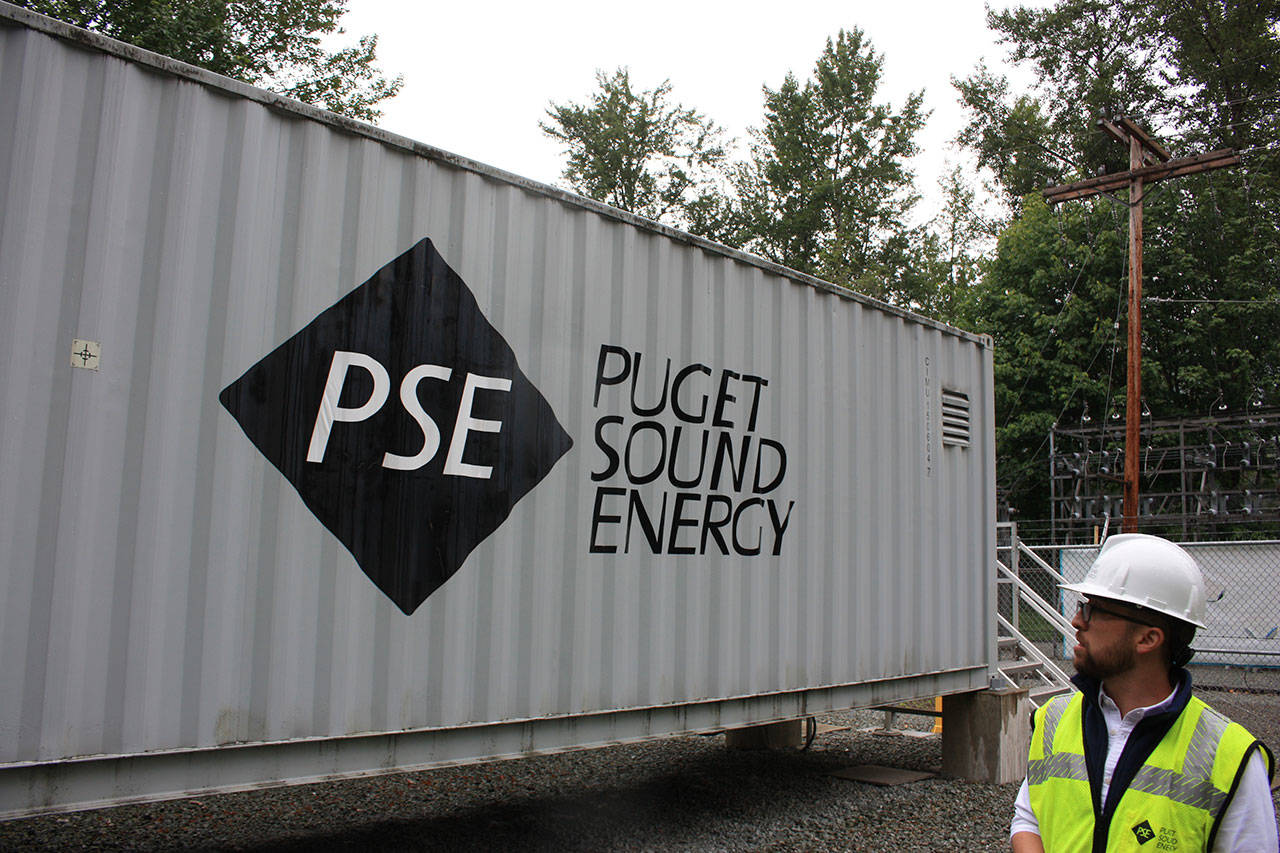On a rainy day in the foothills of Mount Baker, engineers from Puget Sound Energy gathered at a pilot project located just outside of the tiny town of Glacier.
As rain pattered against the exterior of four large shipping containers, inside Paul Jusak, a Puget Sound Energy (PSE) controls engineer, pushed a few buttons an a built-in computer and the thousands of battery cells inside the containers hummed to life. The batteries are charging, and within a few minutes the four containers have charged from 38 to 40 percent. In a matter of seconds, the intake of energy from the power grid can be reversed and sent out to power the town center of Glacier during outages.
“This is definitely a pilot project,” Jusak said outside the containers.
The project, known as the Glacier Battery Storage Project, was created in 2016 and funded partially by $3.8 million in grants from the Washington state Department of Commerce, as well as $7.4 million from PSE. It’s designed to serve as a short term backup power source for the town center of Glacier, which has a single 55kV power line running to it.
Glacier’s remote location, some 35 miles northeast of Bellingham, means it can get up to 100 inches of snow in the winter, and reach temperatures into the 90s during the summer. It also means that when power goes down, it can take crews considerable time to locate and repair the outage.
The battery storage project has about 2 megawatts (MW) of energy, and can run at about 4.4 MW/hours, meaning if it works correctly, it can keep the town’s center powered for about two hours. That’s if it works like it’s supposed to, and by PSE’s own accounts, it has been successful only about half the time in automatically switching on and providing power during storm outages. If it can work in Glacier, it can work anywhere, Jusak said.
The project was completed in 2016 and tests are continuing to boost reliability above 90 percent, at which point PSE may look at ways to expand the program to other regions within its service area.
The technology itself is intricate, with internal computers constantly monitoring 13,000 points within the four shipping containers. Each container holds thousands of battery cells within larger batteries. The batteries are manufactured by BYD, a lithium-ion battery producer in China which makes most of its money making the batteries for electric buses. The batteries in Glacier are essentially double-wide electric bus batteries, Jusak said.
If the battery programs are successful and ultimately expanded, it could provide a way to better store renewable energy for grids in the Pacific Northwest. One of the problems facing renewable energy is it is only generated during specific times of the day. The wind only blows when it blows, and solar energy can only be collected during the day. Power needs to either be shipped quickly across wide stretches of the country, which would require upgrades and integration of public and private grids, or stored to be used later.
John Dooley, PSE’s product development manager, said the entire battery storage industry is in its early phases, but if it expands, it could help store energy from the utility’s Wild Horse Wind Farm in Eastern Washington, for example. PSE is still studying ways a future energy storage program could be rolled out, and importantly, where large amounts of shipping containers filled with batteries might be located.
“It really lends the opportunity to how we can utilize this project,” Dooley said.
According to Pacific Northwest National Laboratory (PNNL) which studies battery storage, the energy storage market is growing quickly, with roughly $320 million in investments in 2016. That number is expected to grow to $3 billion by 2022. However, at least some experts think that creating a system where batteries could store 12 hours of energy across the U.S. would cost about $2.5 trillion. It’s likely the price tag will drop as technology advances, however.
According to the U.S. Energy Information Administration, there were nearly 116 million MWh generated for use in Washington state in 2017, with some 92 million MWh being sold. The majority was generated by hydroelectric dams, which is a renewable resource.
During its last session the state Legislature voted to require all of Washington’s power grid to use clean energy by 2045. That means that nearly a quarter of electricity used in the state must be converted from fossil fuel to alternative forms of power.
PSE relies heavily on fossil fuels, which have the benefit of being able to generate energy any time of the day. It currently pulls about 28 percent of its portfolio from coal and 21 percent from natural gas. However, it has about 800MW of renewable wind energy as well as hydroelectric energy. In total, the utility which serves the Eastside and other areas of the state has some 3,500MW of capacity.
Dooley said there were no specific plans on how the Glacier battery project could be expanded. Once its reliability is increased though, Washington residents could eventually see battery storage projects popping up as the utility shifts away from fossil fuels.


